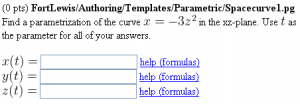Difference between revisions of "Spacecurve1"
Paultpearson (talk | contribs) m (Deprecate examples using LiveGraphics3D) |
Paultpearson (talk | contribs) m (Oops. Remove deprecation.) |
||
| Line 1: | Line 1: | ||
| − | <h2> |
+ | <h2>A Parametric Curve in Space</h2> |
[[File:Spacecurve1.png|300px|thumb|right|Click to enlarge]] |
[[File:Spacecurve1.png|300px|thumb|right|Click to enlarge]] |
||
<p style="background-color:#f9f9f9;border:black solid 1px;padding:3px;"> |
<p style="background-color:#f9f9f9;border:black solid 1px;padding:3px;"> |
||
| − | This PG code shows how to ask a parametric curve question with three answer blanks and use MultiAnswer to check the answer |
+ | This PG code shows how to ask a parametric curve question with three answer blanks and use MultiAnswer to check the answer. |
</p> |
</p> |
||
* File location in OPL: [https://github.com/openwebwork/webwork-open-problem-library/blob/master/OpenProblemLibrary/FortLewis/Authoring/Templates/Parametric/Spacecurve1.pg FortLewis/Authoring/Templates/Parametric/Spacecurve1.pg] |
* File location in OPL: [https://github.com/openwebwork/webwork-open-problem-library/blob/master/OpenProblemLibrary/FortLewis/Authoring/Templates/Parametric/Spacecurve1.pg FortLewis/Authoring/Templates/Parametric/Spacecurve1.pg] |
||
Revision as of 17:23, 7 June 2015
A Parametric Curve in Space
This PG code shows how to ask a parametric curve question with three answer blanks and use MultiAnswer to check the answer.
- File location in OPL: FortLewis/Authoring/Templates/Parametric/Spacecurve1.pg
| PG problem file | Explanation |
|---|---|
|
Problem tagging: |
|
DOCUMENT(); loadMacros( "PGstandard.pl", "MathObjects.pl", "parserMultiAnswer.pl", "AnswerFormatHelp.pl", ); TEXT(beginproblem()); |
Initialization:
Since we will have multiple answer blanks that depend on each other, we need to use |
Context("Numeric");
Context()->variables->are(t=>"Real");
Context()->variables->set(t=>{limits=>[0,10]});
$a = random(-5,-2,1);
$x = Formula("$a * t**2");
$y = Formula("0");
$z = Formula("t");
$multians = MultiAnswer($x, $y, $z)->with(
singleResult => 1,
checker => sub {
my ( $correct, $student, $self ) = @_;
my ( $xstu, $ystu, $zstu ) = @{$student};
return 0 unless $xstu->isFormula;
if (($xstu==$a*$zstu**2) && ($ystu==0)) {
return 1;
} else {
return 0;
}
}
);
|
Setup:
We use |
Context()->texStrings;
BEGIN_TEXT
Find a parametrization of the curve \( x = $a z^2 \)
in the \(xz\)-plane. Use \( t \) as the
parameter for all of your answers.
$BR
$BR
\( x(t) = \) \{$multians->ans_rule(20)\}
\{ AnswerFormatHelp("formulas") \}
$BR
\( y(t) = \) \{$multians->ans_rule(20)\}
\{ AnswerFormatHelp("formulas") \}
$BR
\( z(t) = \) \{$multians->ans_rule(20)\}
\{ AnswerFormatHelp("formulas") \}
END_TEXT
Context()->normalStrings;
|
Main Text:
Notice that we use |
$showPartialCorrectAnswers = 0; ANS($multians->cmp()); |
Answer Evaluation: |
Context()->texStrings;
BEGIN_SOLUTION
Solution explanation goes here.
END_SOLUTION
Context()->normalStrings;
COMMENT('MathObject version.');
ENDDOCUMENT();
|
Solution: |
